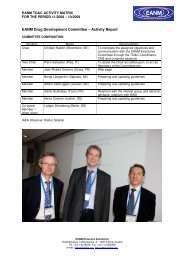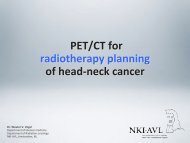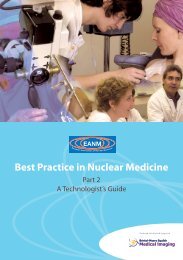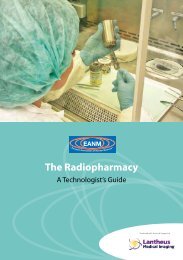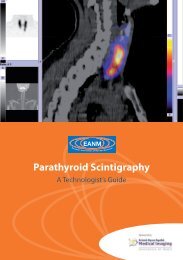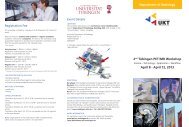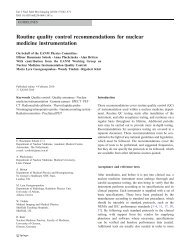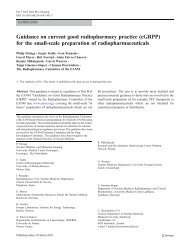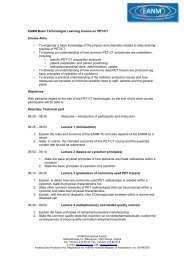Parathyroid Scintigraphy - European Association of Nuclear Medicine
Parathyroid Scintigraphy - European Association of Nuclear Medicine
Parathyroid Scintigraphy - European Association of Nuclear Medicine
You also want an ePaper? Increase the reach of your titles
YUMPU automatically turns print PDFs into web optimized ePapers that Google loves.
•<br />
•<br />
resolution and will optimise counts per pixel<br />
and hence reduce noise.<br />
30× 60-s frames is manageable for the patient<br />
and will maximise counts in the image.<br />
For delayed SPECT, increasing the time<br />
per projection to 90 s will restore the total<br />
counts.<br />
Processing<br />
• The data may be reconstructed using the<br />
methods <strong>of</strong> filtered back projection or iterative<br />
reconstruction. Streak artefacts may be<br />
seen in data reconstructed by filtered back<br />
projection and these will not occur for the<br />
iterative method.<br />
•<br />
•<br />
•<br />
•<br />
•<br />
The raw data can be viewed as a rotating<br />
image and the limits for the region to be<br />
reconstructed chosen.<br />
The region should extend from the parotid<br />
glands to the mediastinum to locate any<br />
ectopic tissue.<br />
The reconstruction programme with chosen<br />
filters is initiated.<br />
Once the reconstruction is completed, the<br />
images are viewed in the transverse, coronal<br />
and sagittal planes.<br />
Datasets can be viewed as volumetric displays<br />
as well as tomographic slices.<br />
99m Tc-sestamibi washout technique<br />
If 99m Tc-sestamibi is used alone, the two sets<br />
<strong>of</strong> images (early and delayed) are inspected<br />
visually.<br />
740 MBq 99m Tc-sestamibi is injected using the<br />
same protocols for patient preparation, i.e.<br />
ID and LMP checks/explanation to patient as<br />
before and imaging typically at 10 min and<br />
2–3 h<br />
•<br />
•<br />
•<br />
•<br />
The camera is peaked for technetium and<br />
a low-energy high-resolution collimator<br />
can be used as images can be taken for<br />
a sufficient time to avoid statistical noise<br />
problems and pinhole collimators are used<br />
in some centres. Zoom can be used but<br />
remember the possibility <strong>of</strong> ectopic tissue.<br />
Neck and mediastinum views are taken with<br />
patient positioning as before. Again, a single<br />
view <strong>of</strong> 600 s counts can be taken or a series<br />
<strong>of</strong> 10×60-s frames acquired so that movement<br />
artefacts can be corrected.<br />
The same parameters and positioning must<br />
be used for the 10-min and late views<br />
Right and left anterior oblique views can be<br />
obtained if required.<br />
•<br />
SPECT can be used in this case also.<br />
All films should be correctly annotated with L,<br />
R and anatomical markers and labelled.






